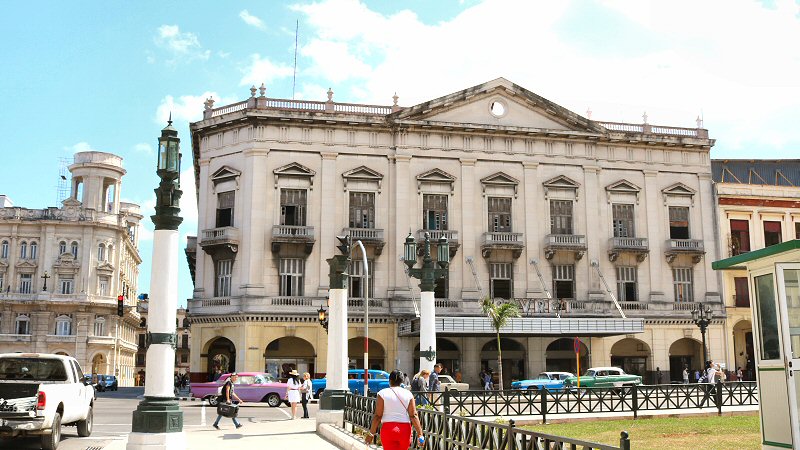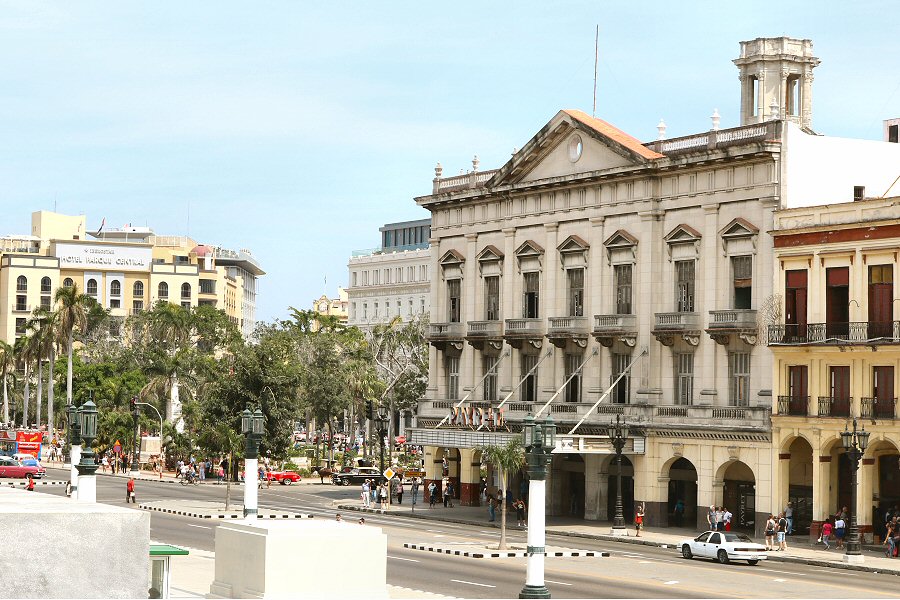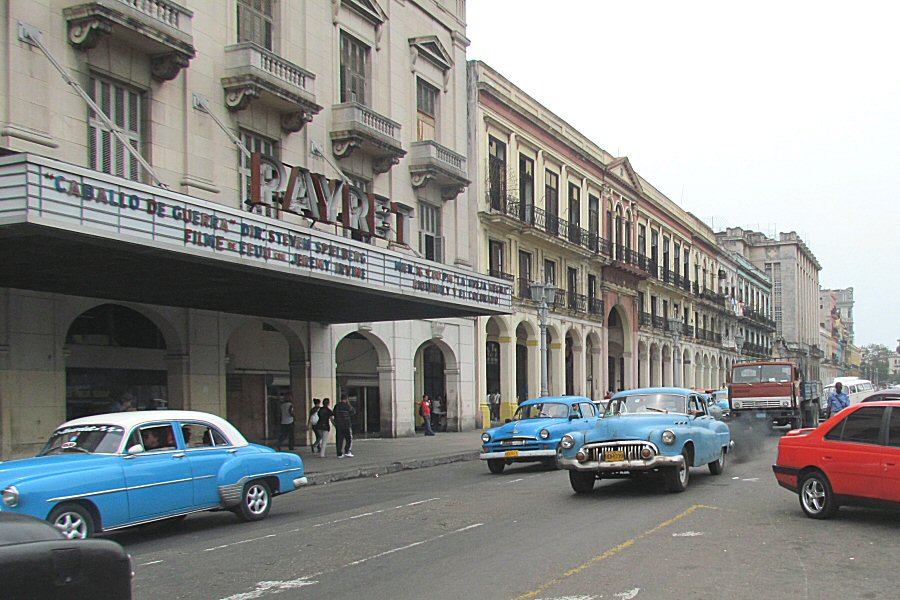
The Teatro Payret is located on the
Paseo de Martí #503, where it intersects with the San José
street, opposite to the Gran Teatro de la Habana “Alicia Alanso”.

The Teatro Payret is one of the first
theaters in Cuba that is used as cinema since 1930s. Once it was
known as "The Cathedral of Spanish Cinema".
In 1875, Catalan Joaquín Payret that had a
great interest in performing arts, particularly in theatre,
decided to build a new theatre in the busy corner of the Paseo
de Martí and the San José street that would be named after his
surname. His purpose was to create an alternative to the Teatro
Tacón that had captured the hearts of the theatre fans since its
inauguration in 1838.
He acquired the land that is occupied by the
Teatro Payret, from the state and sold the famous Café Louvre to
finance the construction. In 1876, the Teatro Payret began to be
built. However, he faced many difficulties. When the walls of
the building reached four meters, a hurricane pulled them down.
Later, another hurricane demolished half of the building, when
the construction was almost finished. Finally, on the scheduled
night of the opening, a gas leak from one of the pipes of the
lighting system endangered the building seriously.
The Teatro Pay opened its doors in
1877. The income of the initial performance (a piano concert by
the notable musician Serafin Ramirez) was granted to the Casa de
Beneficencia y Maternidad (House of Maternity and Charity), a
charity organization that functioned as asylum to children,
delivered by the mothers that for economic reasons or for the
dishonor of having made a slip, was unable to take the care of
the child. The theatre made a good start with the opera La
Favorita by the Italian composer Domenico Gaetano Maria Donizetti
that was much liked by the public.
In 1878, one year after its inauguration,
the name of the theatre was changed to Teatro de la Paz
(Theatre of Peace), referring to the Pact of Zanjón that was
signed after the Ten Years’ War. It was known also as Colisejo
Rojo (Red Coliseum) colloquially, because the red color was
overwhelming at its inside decoration.
In 1882, the Teatro Payret escaped a serious
danger, in that the upper floors collapsed on the lower ones,
when the master walls couldn’t yield the accumulation of the
water that was the result of the heavy rain that had occluded
the drainage pipes. In this unfortunate event three persons
died, including Enrique Sagastizabál, the architect that had
directed the construction of the theatre and the co-owner of the
property, and ten people injured.
This misfortune led Joaquín Payret to fall
into financial crisis. He couldn’t pay back the credit to the
state that he had used for the reconstruction of the building,
so that the property fell into the hands of the public treasury
in 1884, whereas the successful businessman Joaquín Payret that
once had amassed half a million pesos in less than ten years
through commercial activity, fell into gutter, helped for a
while by the Society of Natural Charities of Catalonia and died
in poverty.
The tragic end of Payret reminds us the curse
of Maria del Pino, with whom Payret had a deep conflict,
inflicted by love and money. Maria del Pino cursed against the
building during its construction period. Maybe because of fear,
Payret fulfilled the last will of Maria del Pino. When she died,
the funeral carriage with her remains, remained five minutes in
front of the theatre.
In 1890, the building was auctioned and
first Santiago Pubillones, famous circus entrepreneur, and the
next year Dr. Anastasio Saaverio y Barbales acquired
the property. The renovated building opened its doors again with
performances of Anna Pavlova and Sara Bernhard, among other
outstanding artists.
From
1890s to 1910s, the theatre remained in the property of the
members of the Saaverio family (the sons of Dr. Anastasio
Saaverio y Barbales and Gilbert Pemberton, the husband of
Carlota Saaverio).
In 1925, more than 2.000 doctors from various
regions of the island met in the hall of the theatre and
constituted the Federación Médica de Cuba (Medical Federation of
Cuba), electing Dr. Juan Guiteras Gener the first president.
Unfortunately, Juan Guiteras died five days after his election.
The
hurricane in 1926 destroyed the roof of the building. The same
year it passed to the hands of Rodolfo and Roberto Méndez Peñate
brothers, the latter being lawyer, politician and colonel of the
Liberation Army.
During
the struggle against the tyranny of Gerardo Machado, the fifth
President of Cuba, the basements of the theatre served as
arsenal and hiding place for the insurgents.
In 1935 the Teatro Payret was rented out to
José Vercárcel that reopened the theatre as cinema, projecting
Spanish movies. In a short time, it became known as the
“Cathedral of Spanish Cinema”.
In 1942 the Suseción Falla Gutiérrez, one of
the sugar barons in Cuba, bought the theatre for a considerable
amount of money.
In the course of time, the building demanded
an unpostponable restoration. Thus, in 1951, the Austrian
merchant José Sixto demolished the building of Teatro Payret,
without taking into account that it was considered a National
Monument, and the new Payret was opened completely as a cinema
with an orchestra performance, directed by maestro Rodrigo Prats.
The premiering movie was Pequeñeces (Little Things) with Jorge
Mistral, Aurora Bautista and Sara Montiel. The cinematographic
room that exists today, was used occasionally also for theatre
performances. The Cathedral of Spanish Cinema soon became one of
the largest cinemas in Havana.
After
the Revolution, the building was used mainly as cinema. Due to
its intensive use, restorations were necessary in 1969 and 1981.
The restoration in 2008 was carried out by the Cuban
Institute of Cinematographic Art and Industry to organize the
Festival Internacional del Nuevo Cine Latinoamericano
(International Festival of New Latin American Cinema) in this
building.

Currently, the Payret remains closed due to
functional deterioration and lack of constructive maintenance
since 2008. According the project, the Payret cinema-theater and
the adjoining buildings will give their space to the
construction of a five-star hotel of 300 rooms designed by the
Ministry of Tourism of Cuba, which would occupy the entire block
delimited by the streets San José, Lieutenant Rey, Zulueta and
Paseo del Prado, in Old Havana. The work would be inscribed in
the investment plan designed to celebrate the 500th anniversary
of the founding of Havana.
The structure presents an architecture
of severe classic exterior lines, but the interior has a modern
style, designed by the prestigious firm Arellano y Batista that
was also the contractor of the Bacardí Building and the Malecón.
In the lobby, the bronze sculpture by Rita Longa, called The
Illusion, stands out. On both side of the screen, there are
the bas-reliefs of the nine muses of the Greco-Roman arts, also
works of Longa.

